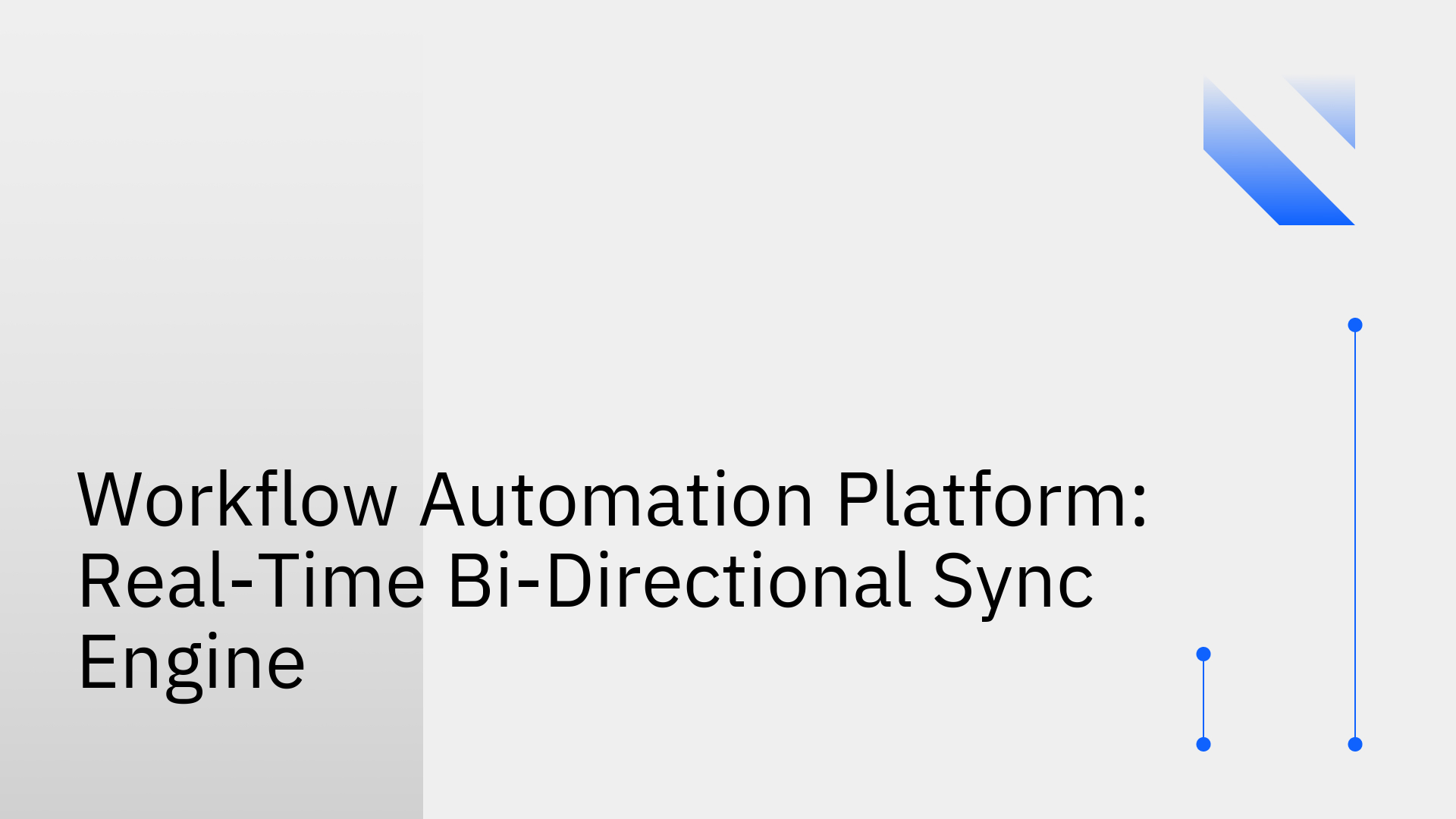
Workflow automation has become the cornerstone of modern business operations, enabling enterprises to streamline processes, boost productivity, and gain a competitive edge.
The global workflow automation market is a testament to this, projected to surge from USD 21.17 billion in 2025 to over USD 80.57 billion by 2035 [2]. However, a critical challenge persists: the gap between automating workflows and ensuring the underlying data that powers them is consistent, accurate, and available in real-time across all systems.
This disconnect creates a ceiling on operational efficiency. The solution lies in a real-time bi-directional sync engine, a foundational technology that bridges this gap and unlocks true, end-to-end process automation.
As organizations adopt a growing stack of specialized SaaS applications, CRMs, ERPs, databases, and marketing tools, their data becomes increasingly fragmented. This creates data silos that lead to significant operational consequences:
Traditional integration tools, including basic task automators and even many sophisticated Integration Platforms as a Service (iPaaS), often fall short. They typically depend on periodic, trigger-based, or one-way data pushes, which are inadequate for mission-critical operations that demand real-time data integrity.
Furthermore, integrating modern cloud platforms with legacy systems presents a significant hurdle, as these older systems were not designed for the fluid, API-driven world of today [3]. This is a common pain point for even the top workflow automation platform for real-time enterprise processes to solve.
A real-time bi-directional sync engine is a specialized technology architected to maintain data consistency across multiple, disparate systems with sub-second latency. Unlike conventional one-way data pipelines, it establishes a continuous, two-way flow of information.
"Bi-directional" or "two-way" sync means that a change originating in any connected system is immediately and automatically propagated to all others. For instance, if a sales representative updates a customer's contact information in Salesforce, that change is instantly reflected in the company’s NetSuite ERP and its PostgreSQL operational database.
Conversely, an update made in the database will propagate back to the CRM and ERP. This model ensures that every team is working from the same, most current dataset. This is fundamentally different from one-way syncs that only push data in a single direction, which you can learn more about in this guide to real-time data synchronization to sync CRM with ERP effortlessly.
The "real-time" aspect is crucial; it signifies that this synchronization occurs nearly instantaneously, eliminating the data lag that plagues batch-based processes.
Several advanced technologies underpin these powerful engines:
Understanding how these technologies function is key to appreciating why real-time data sync that actually works is a complex engineering challenge solved by specialized platforms.
Integrating a real-time bi-directional sync engine into your workflow automation strategy is not just an enhancement; it is a transformative shift that delivers profound benefits. Data sync platforms empower businesses to connect disparate data sources for better insights and automation [6].
Stacksync is a workflow automation platform purpose-built around a powerful, real-time bi-directional sync engine. It is engineered from the ground up to solve the core challenge of data fragmentation by providing true, sub-second data synchronization across your entire technology stack.
Our platform is designed for real-time speed, ensuring that your automated workflows are powered by the most current and accurate data possible.
Stacksync moves beyond the limitations of traditional integration tools with a technically rigorous and focused architecture.
The landscape of workflow automation is rapidly evolving. The convergence of automation with technologies like IoT and generative AI is creating new possibilities, but it also raises the stakes for data management [1]. Platforms that cannot handle real-time, bi-directional data flow will struggle to support the next generation of intelligent, event-driven enterprise processes. The broader technology trend confirms this shift, with platforms like Firebase Realtime Database [7] and Supabase Realtime [8] delivering real-time capabilities to developers [1] [2].
As organizations strive for hyper-automation, the need for a synchronized data backbone becomes non-negotiable. It is the foundation upon which resilient, efficient, and intelligent automated systems are built. When you compare real-time workflow automation platforms, the ability to deliver true, bi-directional synchronization at scale emerges as the key differentiator.
Traditional workflow automation is incomplete. Without a real-time data synchronization backbone, it can only automate fractions of a process, leaving critical data gaps that require manual intervention and introduce risk. A real-time, bi-directional sync engine eliminates data silos, eradicates manual reconciliation, and empowers your business to operate with unparalleled speed and accuracy.
Stacksync provides this powerful engine as the core of its workflow automation platform. We enable you to connect your most critical systems, CRMs, ERPs, and databases and automate processes with the confidence that comes from a single, unified source of truth.
Transform your operations and unlock true, end-to-end automation. Discover how Stacksync can unify your data and supercharge your workflows.